To extract plant dyes for soap colors, you'll need basic tools like a glass bowl, blender, and straining cloth. Start by processing fresh or dried botanicals into small pieces, then choose either water-based or oil-based extraction. For water-based dyes, steep plant materials in boiling water for several hours. For oil-based, infuse dried botanicals in carrier oils at a 1:5 ratio below 140°F. Test the color stability and monitor pH levels during saponification – there's much more to discover about achieving vibrant, natural soap colors.
Essential Tools and Equipment for Plant Dye Extraction
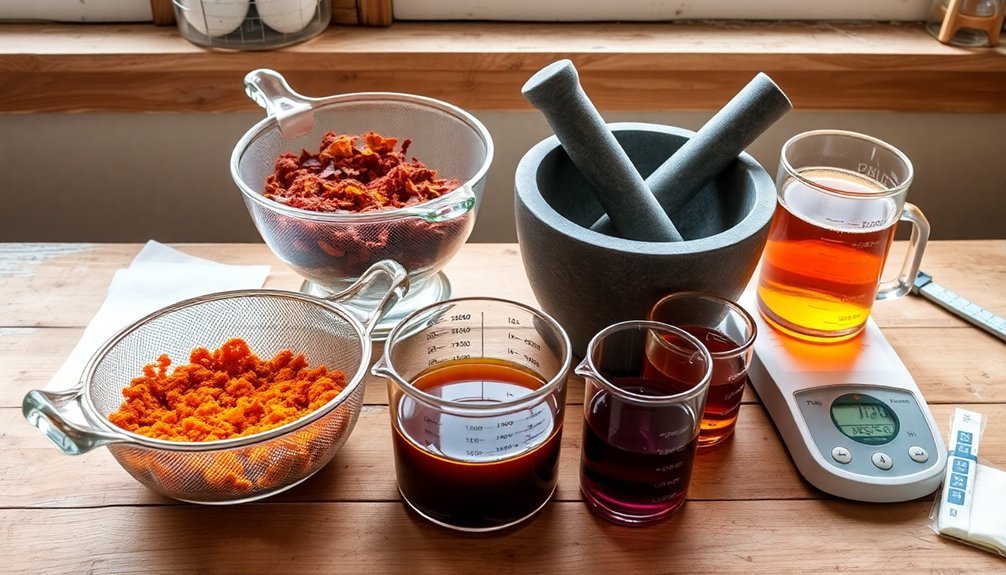
Successful plant dye extraction requires specific tools and equipment to guarantee quality results.
You'll need to start with a glass or steel bowl as your primary workspace, as these materials won't react with the plant dyes during the extraction process.
Essential tools for processing plant material include a blender, grater, or mortar to break down the raw ingredients into smaller, more manageable pieces.
You'll also need cloth for filtering your dye extracts to remove any remaining plant particles.
For the extraction itself, keep water or ethanol on hand as your solvent – ethanol's particularly useful since it can extract both water-soluble and oil-soluble pigments.
Don't forget an airtight container for storing your finished dye extracts, as proper storage will help maintain their vibrancy and prevent deterioration over time.
Selecting and Preparing Botanical Materials
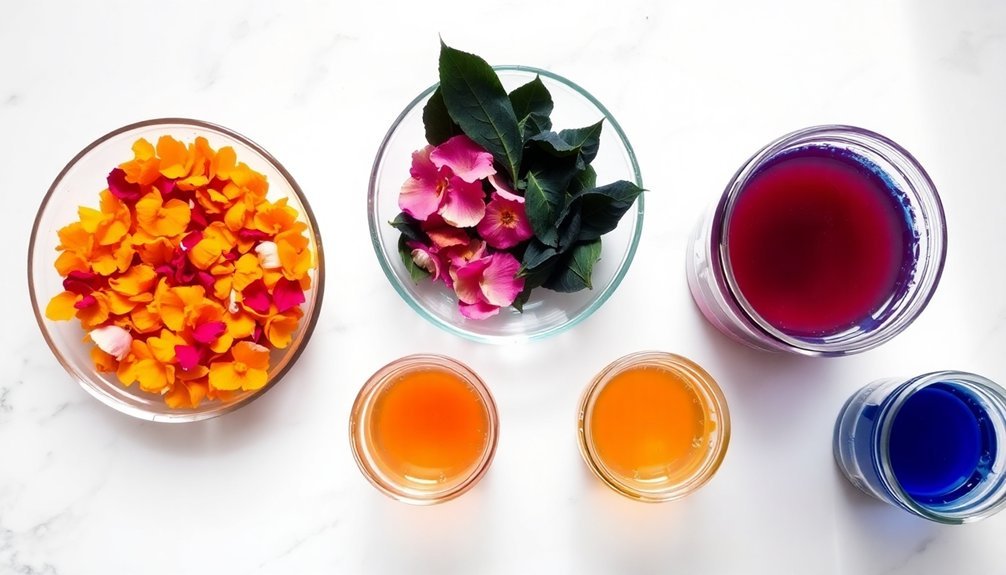
When creating natural soap dyes, selecting the right botanical materials serves as your foundation for achieving vibrant, lasting colors. You'll want to choose diverse plant parts like leaves, flowers, and roots, as each contains unique color pigments. Beetroot gives you red, turmeric produces yellow, and alkanet creates purple hues.
Before starting your dye extraction process, verify your botanical materials are fresh or properly dried and free from mold or contaminants.
You'll need to process them using a blender, grater, or mortar to increase the dye yield. Begin by cleaning your chosen materials thoroughly, then chop them into smaller pieces for better pigment release.
Select the appropriate solvent – either water or ethanol – based on the specific color pigments you're targeting, as this affects your extraction success.
Oil-Based Extraction Methods
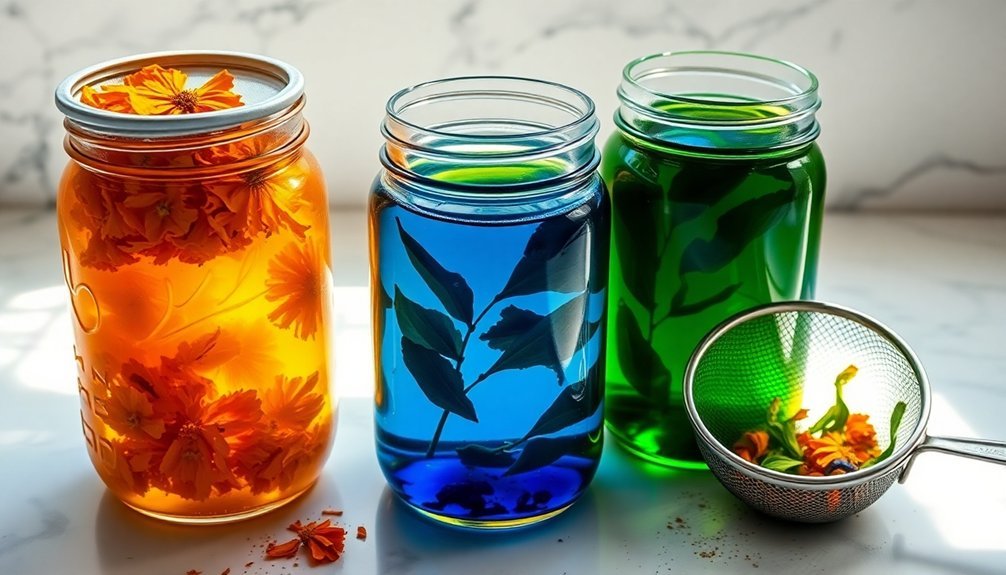
Begin your oil extraction journey by selecting dried botanicals and blending them with carrier oils at a ratio of 1:5, adjusting as needed for specific plants.
You'll want to maintain gentle heat below 140°F while infusing your oils to maximize color extraction without damaging the plant material.
The infusion process can take several weeks to months, but you'll achieve the most stable and vibrant colors by allowing sufficient time for the oils to fully capture the botanical pigments.
Infusing Dried Plant Materials
The art of infusing dried plant materials into carrier oils offers soap makers a natural way to create vibrant colors for their products. To extract dyes, combine your dried botanicals with a carrier oil using a 1:2-3 ratio, depending on your desired color intensity. You'll need to let the mixture infuse for several weeks, or speed up the process using gentle heat below 140°F.
| Plant Material | Infusion Time | Method |
|---|---|---|
| Fresh Herbs | 4-6 weeks | Cold |
| Dried Flowers | 2-4 weeks | Cold |
| Roots/Bark | 1-2 weeks | Heat |
Once your infusion is complete, strain the infused oil through a fine mesh to remove plant particles. You can now incorporate this natural colorant directly into your soap recipe, substituting it for regular oils while maintaining your formulation's balance.
Solvent Selection Guidelines
Selecting the right oil-based solvent forms the foundation for successful plant dye extraction in soapmaking.
When you're working with natural dyes, choosing liquid oils that complement your botanical type will greatly impact your color results. Oil extraction excels at pulling color pigments from dried plant materials, making it your best choice for vibrant soap colors.
- Choose oils based on your specific botanical type – some plants release pigments better in lighter oils, while others need heavier carriers.
- Start with completely dried plant materials to prevent oil rancidity.
- Calculate your oil-to-plant ratio carefully, as each botanical requires different proportions.
- Plan for an extended infusion process, as proper color development takes several weeks.
Remember that patience during the infusion process will reward you with richer, more stable colors for your soap creations.
Water-Based Extraction Techniques
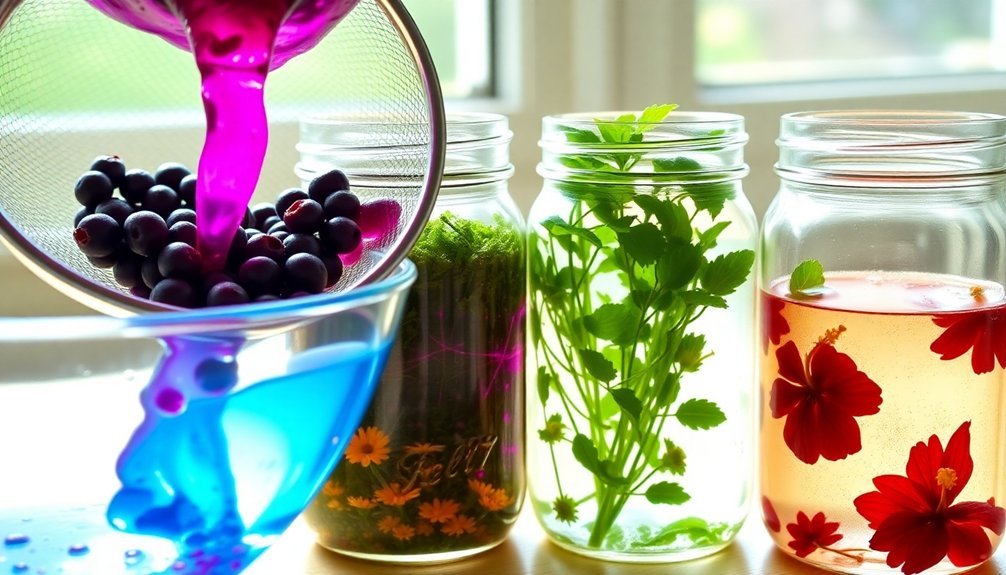
Among natural soap-making techniques, water-based extraction stands out as one of the simplest and most effective methods for obtaining plant dyes.
You'll need to start by chopping or grinding your plant materials to maximize the extraction process. Then, add them to boiling water, which helps dissolve the plant pigments effectively.
Proper preparation of plant materials through grinding or chopping ensures maximum pigment release when combined with hot water.
Let your mixture steep for several hours or overnight to achieve the strongest possible dye concentration. During this time, the water will draw out the natural colors from your plant materials.
Once you've finished steeping, you'll want to filter the mixture through a cloth or fine mesh strainer. This step guarantees you're left with a clear liquid dye that's ready for soap making.
Remember that the stability of your dye may vary depending on your plant choice and soap's pH level.
Creating Color-Stable Soap Infusions
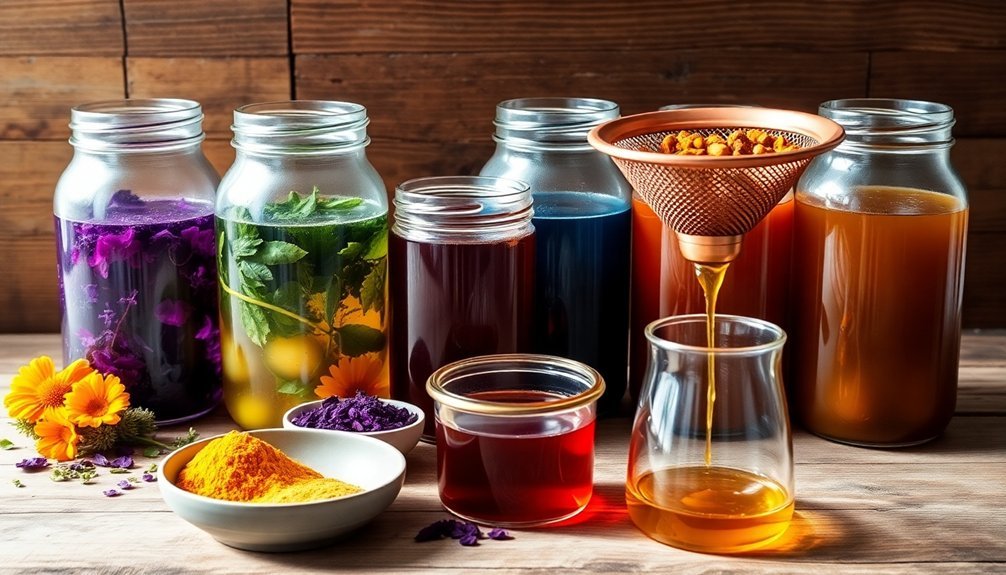
To create vibrant, lasting colors in your handmade soaps, you'll need to master oil-based infusion methods using either heat or cold extraction techniques.
You can test your infusion's color stability by placing a small sample in direct sunlight for several days and monitoring any changes in hue or intensity.
Herbs like calendula, alkanet root, and madder root typically produce the most reliable and stable colors for soap making, making them excellent choices for beginners.
Oil-Based Infusion Methods
When creating natural soap colors, oil-based infusions offer one of the most reliable methods for extracting plant pigments. The process involves soaking dried plant materials in a carrier oil until the natural dyes transfer into the solution.
You'll want to maintain precise temperature control, keeping it below 140°F to preserve the integrity of your plant dyes.
- Choose your ratio carefully: start with 1 part plant material to 2-4 parts carrier oil
- Use a double boiler or slow cooker to gently heat your infusion
- Allow sufficient time for extracting pigments – from several hours up to weeks
- Strain your infused oil thoroughly before adding it to your soap
For best results, watch your temperature closely and adjust your infusion time based on the specific plant materials you're using and your desired color intensity.
Testing Color Stability
Testing your plant-dyed soap infusions for color stability is critical before scaling up production. Start by conducting pH tests on your natural colorants to understand how they'll react during saponification. The soap's pH level can drastically change your expected color outcome.
Create small batches to experiment with different plant-to-oil ratios, documenting each combination's results. You'll want to monitor these test batches throughout the curing process to observe any color changes.
Store your infused oils in a dark place using airtight containers to prevent degradation from light and oxygen exposure.
Watch your test soaps under various lighting conditions and through different stages of curing. This observation period will help you identify which natural colorants maintain their vibrancy and which tend to fade, ensuring consistent results in your final products.
Best Plants for Soaping
Although many plants can produce natural soap colorants, only a select few deliver reliable, long-lasting hues. For the best results in your cold-process soap, you'll want to focus on plants and materials known for their stable hues and color retention.
- Madder root creates beautiful pink shades that remain vibrant throughout the curing process.
- Alkanet-infused oil produces stunning purple tones during saponification.
- Turmeric delivers consistent yellow natural color that stands the test of time.
- French clays offer dependable alternatives to plant dyes, especially for green color.
While leaves like spinach might seem appealing for their green color, they tend to fade quickly. Instead, opt for ingredients like green clay or spirulina for lasting results.
Remember to infuse your oils with dried plant materials before soap making to maximize color extraction and stability.
Testing and Incorporating Plant Dyes in Soap
Since successful natural coloring requires careful testing and observation, you'll need to start with small batches to understand how plant dyes interact with your soap.
Begin by infusing your oils with plant materials before adding them to your soap recipe, as this step greatly improves color retention. You'll want to measure carefully, using 1 teaspoon to 1 tablespoon of plant dyes per pound of soap, depending on your desired color intensity.
Infuse oils with natural plant dyes before soapmaking, using 1-3 teaspoons per pound for best color retention and vibrancy.
Watch how colors change during saponification, as some dyes like alkanet can transform dramatically. Keep detailed notes of your results for future batches.
When incorporating your dyes, consider whether they're water-soluble or oil-soluble, as this affects how they'll behave in your soap. This knowledge will help you achieve consistent, vibrant results in your naturally colored soaps.
Frequently Asked Questions
How to Extract Plant Dyes?
You'll need to blend your chosen plant material, mix it with warm water or ethanol, create a paste, add boiling water while stirring, and filter through cloth. Store the extracted dye carefully.
What Are the Natural Dyes From Plants for Soap?
You'll find red from madder root, yellow from turmeric or dandelions, and purple from alkanet root. Don't forget that other plants like indigo for blue and chlorophyll for green work well too.
How Do You Extract Pigments From Plants?
You'll need to clean and grind your plant materials, then choose either water or ethanol as your solvent. Simmer water-soluble pigments or steep in ethanol, then filter and store in airtight containers.
How to Extract Colors From Nature?
You'll need to gather plant materials, chop them finely, and soak them in water or ethanol. Heat the mixture gently, let it steep for hours, then strain it through cloth to collect your natural dye.
In Summary
You'll find that extracting natural plant dyes for soap making is both rewarding and sustainable. Whether you're using oil-based or water-based methods, remember to test your dye concentrations and pH levels before adding them to your soap batches. Start with small amounts, document your results, and you'll soon develop a reliable collection of botanical colorants that'll give your handmade soaps unique, natural hues.

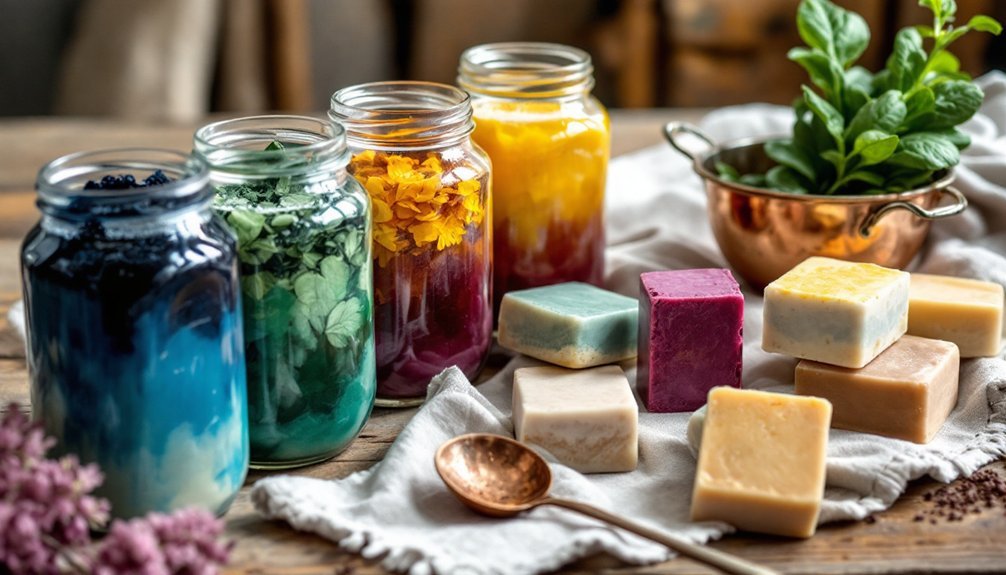



Leave a Reply